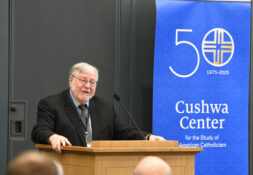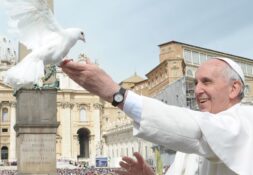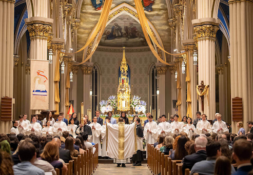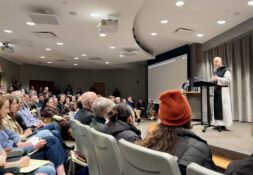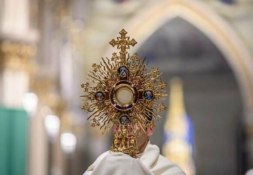Anticipating the implementation of the third Roman Missal this Advent season, the Orestes Brownson Council hosted “Sacred Then…Sacred Now: A Positive Assessment of the New English Translation of the Roman Missal.” The lecture was delivered by Fr. Neil J. Roy, STL, PhD. Recently appointed chaplain and associate professor at the College of Saint Mary Magdalen, he also previously served as a visiting professor of theology at Notre Dame.
Father Roy identified several benefits of the new translation. First, the new translation expresses more accurately the original Latin. It also expresses a “clearer sense of sacredness and greater openness to mystery” and possesses clearer resonances with Scripture.
In addition, Fr. Roy said the new translation draws greater attention to the music of the Mass. He praised the new translation’s encouragement of “singing the Mass” rather than “singing at the Mass.” The third edition of the Roman Missal includes a “generous provision of musical texts” so that the liturgy may be chanted.
These English chants have a close musical correspondence with the Latin chants; the chanted Creed clearly resonates with Credo III, and the memorial acclamations are also similar to their musical Latin counterparts.
Fr. Roy stated that “the liturgy exercises a formative influence on us as Catholics.” Referencing the Holy See’s instruction LITURGIAM AUTHENTICAM, he explained, “The instruction demands precise theological and liturgical language to express theological truths in the context of the sacred liturgy. The liturgy must express what the Church believes. LEX ORANDI must express the LEX CREDENDI.”
The first benefit of the 2011 translation of the Roman Missal is “a more accurate rendering of the Latin prayer texts.” In the 1970 ICEL translations, “dynamic equivalence” was the chief operative principle, that is, allowing an approximate summary or paraphrase of the original Latin prayer texts into English.
The new translation follows the Latin more literally. The response “and also with you” has changed to “and with your spirit,” a direct translation of “et cum spiritu tuo.”
Another subtlety the new translation expresses relates to the communal aspect of the liturgical sacrifice. The translation changed “that our sacrifice” to “that my sacrifice and yours.” The 2011 translation shows that it is one sacrifice, but it is offered in a different manner. In Fr. Roy’s words, “the priest offers it as a priest; the Church offers it as the Church.”
According to Fr. Roy, the new translation leaves room for an element of mystery, as seen in the example of Melchizedek’s sacrifice mentioned in the Roman Canon. The Latin text does not specify “bread and wine” as the sacrifice offered. The new translation reflects this mystery, simply saying, “the offering of your high priest Melchizedek.” He suggested that this change is consistent with elements of patristic thought, particularly with that of St. Ambrose, who wrote that Melchizedek was like Christ showing his Body and Blood before Abraham.
Another benefit of the new translation is the use of the feminine pronoun in reference to the Church. The Church is referred to as the bride of Christ. “We are being tutored in referring to the Church as she, not as an external object or inanimate object…the Church has a feminine quality and persona, a certain vitality, life, and character,” said Fr. Roy.
Clearer continuity with Scripture are seen in the phrase taken from the centurion in Luke 7:6, “O Lord I am not worthy that you should enter under my roof, but only say the word and my soul shall be healed.”
According to Fr. Roy, the new translation “demonstrate[s] the fidelity and exactness demanded by LITURGIAM AUTHENTICAM,” while clarifying doctrinal and spiritual elements. “Allowing for an element of mystery is an important contribution here, and recognizing the subtlety of figures like Melchizedek, and character of ordination, are important.”
Sandra Laguerta is a theology major who finds the third edition of the Roman Missal beautiful. [d1] Contact her at slaguert@nd.edu if you have the skills to make a sidecar for her bike Veritas. A video-recording of this lecture, as well as a follow-up interview with Fr. Roy, is scheduled to appear on the Orestes Brownson Council’s website.
[d1]This joke is extremely obscure, even for someone who knows you really well!
